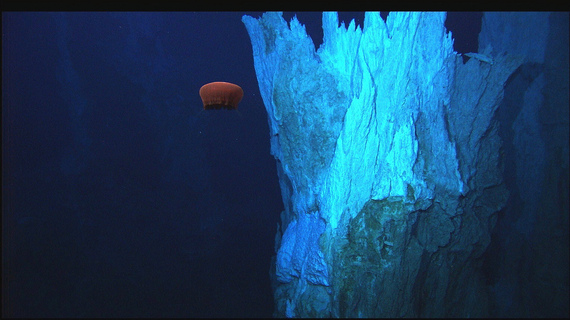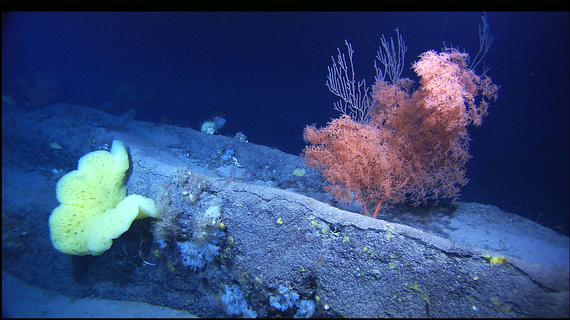Adding to concerns about the disastrous decline in ocean ecosystems, now there is another emerging threat - deep sea mining. While shallow water mining for sand, gold, tin, and diamonds has been conducted for decades, commercial deep sea mining has yet to occur anywhere. But that's about to change.
Extensive deep sea mineral exploration is currently underway in international waters governed by the International Seabed Authority (ISA), under the U.N. Convention on Law of the Sea (UNCLOS), and within Exclusive Economic Zones (EEZs) of many coastal nations.
There are currently three main types of deep sea mineral deposits of interest to industry and governments:
1. Polymetallic nodules (also called "manganese nodules") are potato-sized metal nodules found on the abyssal plain from 4,000 m - 6,000 m deep. These nodules are rich in manganese, nickel, cobalt, copper, lithium, molybdenum, iron, and Rare Earth Elements. Nodules grow slowly over millions of years, to diameters from 5 cm - 50 cm, and host unique invertebrate communities. Currently, 13 national consortia operate exploration leases on 4.5 million km2 of the Clarion-Clipperton (Fracture) Zone (CCZ), between Baja and Hawaii. The U.S., as a non-party to UNCLOS and ISA, issued exploration leases on its own to Ocean Minerals Company (OMCO), a subsidiary of defense contractor Lockheed Martin, to explore for nodules in the CCZ. The only nodule deposits being seriously considered within a national EEZ at present are in the Cook Islands in South Pacific.
2. Seafloor Massive Sulphide (SMS) deposits are found beneath deep sea hydrothermal vents along the 67,000 km of volcanically active mid-ocean ridges and back arc basins, between 1,500 m - 5,000 m deep. These contain high-grade copper, gold, silver, zinc, and other trace metals. Deep sea hydrothermal vent ecosystems were first discovered in 1977 at the Galapagos Rift, and stunned the world of science, as these vent systems rely entirely on chemosynthesis rather than photosynthesis - the first ever known. Over 300 deep sea vent systems have been discovered so far, and it is estimated that perhaps only 500 - 5,000 may exist in the world ocean, making this one of rarest ecosystems in Earth's biosphere. China and Korea hold contracts to explore SMS deposits in international waters of the Indian Ocean, and Russia and France hold exploration leases on the Mid-Atlantic Ridge. Other SMS deposits being considered are in waters of Papua New Guinea (PNG), Vanuatu, Palau, Niue, Fiji, Micronesia, Solomon Islands, Tonga, and New Zealand. The Nautilus Minerals "Solwara 1" project in PNG waters is fully permitted, the mining ship and equipment are being built, and mining is scheduled to begin in 2018. This would be the first commercial deep sea mining project in history.
3. Cobalt-rich ferromanganese crusts are found on summits and flanks of seamounts at 400 m - 4,000 m depth. There are some 10,000 seamounts in oceans rising at least 1,000 m above the seabed (and perhaps another 90,000 smaller seamounts). Many are in EEZs of central Pacific islands (Federated States of Micronesia, Marshall Islands, Hawaii, Johnston Atoll), and in international waters of the tropical Pacific. Metal crusts form on shoulders of seamounts, rich in cobalt, nickel, copper, iron, manganese; rare metals such as tungsten, platinum, bismuth, tellurium, etc.; and Rare Earth Elements. Crusts grow slowly, 1 mm - 5 mm per million years, and can reach total thickness of up to 260 mm. Seamount crusts are currently being explored by China and Japan in international waters of the western tropical Pacific, but many feel actual mining of seamount crusts would be by far the most problematic and least feasible.
Marine phosphate (fertilizer) and methane hydrate (energy) resources found in shallower waters, 100 m - 500 m deep, are often discussed in context with deep sea minerals. Marine phosphate mining is in consideration off Namibia (currently under moratorium), New Zealand (the environmental permit was denied earlier this year, but the developer is considering reapplying next year), and off Baja Mexico, where Odyssey Marine has submitted its EIA for mining the Don Diego phosphate deposit in 70 m water depth, 12-25 miles offshore. Japan has successfully tested methane hydrate, or "fire ice," extraction from its offshore waters.
But here's the problem. The deep ocean, where mining is proposed, constitutes the largest and least understood biological habitat on Earth. It's an Alice-in-Wonderland world of extremes, extraordinary adaptions, bizarre organisms, beauty and mystery. The region is characterized by darkness (infused with sparkling bioluminescence), extreme pressure, cold temperatures, high biodiversity (perhaps millions of species, most yet to be identified), slow growth and reproductive rates, and high sensitivity to disturbance (low resilience). Given our poor understanding of deep sea ecosystems, growing industrial interest, rudimentary management, and insufficient protected areas, the risk of irreversible environmental damage here is real.
Environmental risks and impacts of deep sea mining would be enormous and unavoidable, including seabed habitat degradation over vast ocean areas, species extinctions, reduced habitat complexity, slow and uncertain recovery, suspended sediment plumes, toxic plumes from surface ore dewatering, pelagic ecosystem impacts, undersea noise, ore and oil spills in transport, and more.
Due to the global rarity of deep sea hydrothermal vent ecosystems, the impact of vent mining would be disproportionately high relative to terrestrial mining. Full-scale nodule mining on the abyssal plain would affect thousands of square miles of ocean floor, kill attached invertebrate communities, and create huge subsea sediment plumes that would flow and settle over thousands of square miles of seafloor. Such sedimentation would smother seabed habitat, reduce habitat complexity and biodiversity over vast areas, and post-mining recovery would be extremely slow. Mining of cobalt crusts on seamounts would cause enormous, possibly irreversible impacts to unique, productive seamount ecosystems.
Clearly, we need to avoid such ecological damage. Before any deep sea mining moves ahead, we would need much more extensive scientific research - species identification, community ecology, distribution, genetics, life histories, resettlement patterns, resilience to disturbance, and at least a 10-year continuous time series of observations to understand dynamics of proposed mining sites over-time. In addition, we need more robust management regimes at the ISA and in coastal nations, royalty-sharing and liability agreements, stakeholder engagement, and significant advancements in subsea technology. Until this is achieved, the only wise policy is a global moratorium on all deep sea mining.
The need for more deep sea Marine Protected Areas is paramount. New Zealand established its Kermadec Ocean Sanctuary this year on over 620,000 km2 of the islands and submarine volcanoes northeast of the main islands; Cook Islands established a marine reserve on 1.1 million km2 (over half) of their EEZ; the U.S. established a 1.2 million km2 Pacific Remote Islands Marine National Monument; and the ISA established Areas of Particular Environmental Interest (APEIs) over about half (or about 2.3 million km2) of the area currently under lease in the CCZ. This is a good start, but still insufficient.
Industry and governments recognize the huge challenges in mining the deep ocean, but are resolved to move forward anyway. As justification, they invoke the "peak minerals" argument, depletion of land-based minerals, and a projected increase in mineral demand in the world economy.
But mining proponents habitually avoid discussing the opportunity to reduce mineral demand by increasing the efficiency of metal use in the global economy, cradle-to-cradle design, recycling, and landfill mining. To build a sustainable economy, we will have to break the "economy of waste" - mining raw minerals, using them once or twice, discarding them, and continuing the demand for mining raw minerals. Surely at some point, with smart renewable metal use, we will have enough minerals already up into the global economy and won't need to keep digging holes for more. The sooner we get there, the better.
The Nautilus Minerals "Solwara 1" vent/SMS mining project in PNG waters will likely be the first deep sea mining project, with others following elsewhere in PNG, Tonga, and Fiji. Others projects to watch in national waters include Odyssey's Don Diego phosphate mining project off Baja, and manganese nodule mining in the Cook Islands. Mining on the international seabed is likely 5-10 years off, but there is intense political pressure to do so.
This emerging industry would result in serious impacts to our oceans, so it is critical for civil society to engage now, in the early stages of exploration and development. It would be truly unfortunate if we allow the same industrial paradigm that destroyed much of the terrestrial ecosystems of our home planet to do the same in the deep sea. It is time to change this model.
This is a very big deal, and we need to pay close attention. Groups such as the Deep Sea Mining Campaign, MiningWatch Canada, Greenpeace, Earthworks, and the Center for Biological Diversity are doing great work on the issue. The future of our oceans, and thus our planet, may depend on their success.


